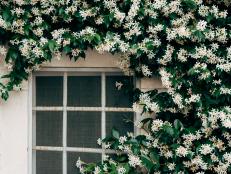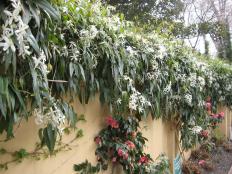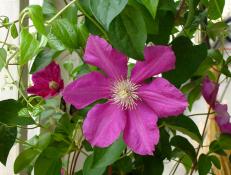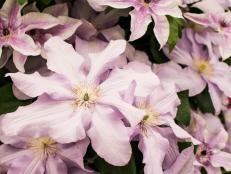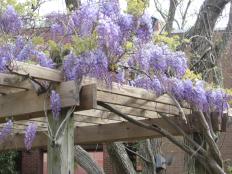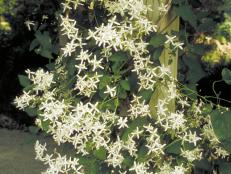Choosing Plants for Arches and Pergolas
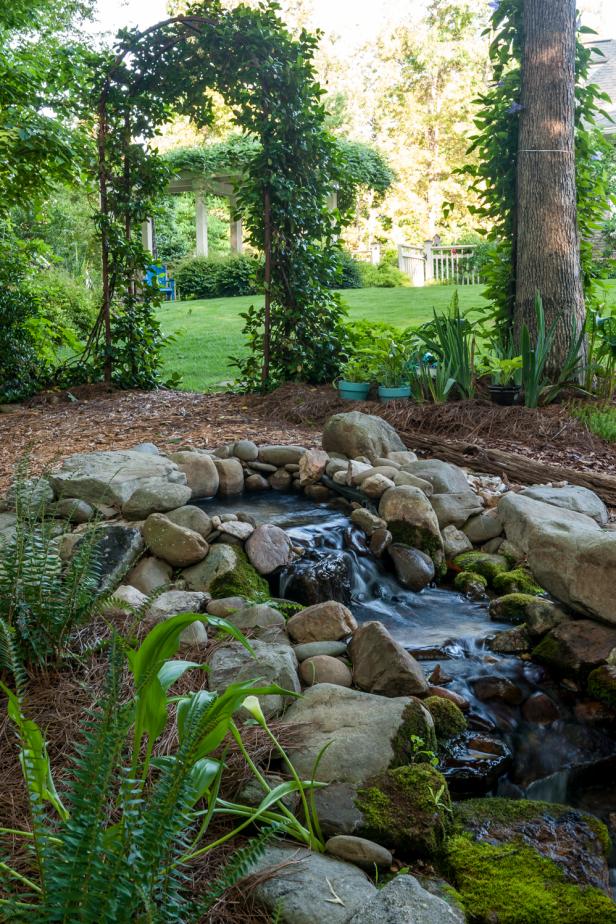
Photo courtesy of Joseph DeScoise
Covering arches and pergolas with plants will provide vertical interest outside and will often form a good visual link between the house and garden. Climbers fulfill many functions in the garden, especially when associated with arches and pergolas; not only can they give exotic fragrances and color, but they can also help provide dappled shade and privacy for seating areas.
Different Habits of Climbers
Climbing plants grow in several different ways. There are those, such as ivy, that climb by means of aerial roots, and those – like Virginia creeper (Parthenocissus) — that stick to the wall with suckers. By their very nature these plants tend to stay flat to a wall and, while they may be ideal on solid brick arches, they are less suitable for covering structures made of wood or metal. For these, twining plants are preferable since they will not only cover all sides of the posts but will also reach from beam to beam, giving a greater coverage of foliage and consequently more shade.
Some plants, such as passionflowers, twine around posts by sending out tendrils, while the whole stem of other plants, such as honeysuckle, winds around posts and beams. However they cling, all climbers benefit from a helping hand when planted; tie them onto vertical wires attached to the pergola posts. For most plants, this is sufficient assistance and they will soon start climbing, but roses in particular may need to be tied in more often: they will climb readily only if there are other host plants into which they can hook their thorns.
Many woody climbers, especially wisteria and many of the climbing roses, are extremely heavy when mature and need the support of a very sturdy framework. Do consider which plants you would like to grow when choosing an arch or pergola; some simple kits may not be strong enough for your ideal plant choice.
Benefits of Annual Climbers
- These one-season plants provide interest while slower-growing permanent plants establish.
- Annuals can be trained through permanent climbers or shrubs to keep interest through the seasons.
- These climbers offer shade in summer but disappear to let in more light during winter.
- Some fast-growing tender climbers can be grown as annuals in areas of winter cold; they can be enjoyed without needing to overwinter.
Rapid Coverage
Short-term cover may be provided by annual climbers, many of which have the added benefit of flower or fragrance; morning glories (Ipomoea) are a good example.
Certain herbaceous climbers are useful for growing over simple structures near houses or in roof gardens, where the summer foliage will provide shade and shelter, but, in winter when the growth has died back, the bare structure allows more light into adjacent rooms. Hops (Humulus) is a fine example of such a climber.
If fast coverage for screening is your priority, choose carefully: vigor can be a short-lived virtue. The infamous mile-a-minute vine (Fallopia baldschuanica) will undoubtedly cover a pergola extremely quickly, but it will soon engulf anything else growing nearby as well. Clematis montana or many of the honeysuckles, while fast growing, will be less invasive and much more attractive as well.
Evergreen climbers, such as Clematis armandii, are useful for giving both cover and privacy throughout the year.
Growing a number of climbers at once can guarantee year-round interest, but it is not always necessary to swamp an arch with climbers: sometimes a single specimen looks more effective. This is especially true of the white wisteria, Wisteria floribunda (also known as 'Alba'), whose long clusters of fragrant pea flowers hang down from overhead beams in an impressive display.
Suggested Climbers for Speedy Coverage
Annual climbers:
Eccremocarpus scaber (Chilean glory flower) Ferny leaves, spikes of tubular orange flowers.
Lathyrus odoratus (Sweet pea) Strongly scented flowers in many colors.
Rhodochiton (Purple bell vine) Tubular purple flowers with mauve-pink calyces all summer.
Thunbergia (Black-eyed Susan vine) Heart-shaped leaves and black-centered orange flowers from summer to autumn.
Fast-growing climbers:
Clematis montana ('Rubens') Masses of pink flowers in late spring.
Parthenocissus tricuspidata (Boston ivy) Ivy-like leaves, brilliant crimson in autumn. This climber has suckers, so it is suitable only for brick or stone.
Passiflora caerulea (Passionflower) Intricate flowers from summer into autumn, then orange fruits.
Solanum crispum ('Glasnevin') Purple star-shaped summer flowers. Evergreen in mild areas.
Taking Care of Your Planting
It is important to note a plant's preferred site and conditions before you make your selection to ensure your proposed position fulfills its basic requirements. Once planted, all climbing plants require some routine maintenance to keep them healthy and to control their growth.
Climbers produce a lot of growth from a small root ball, so they need regular watering and feeding. A thick layer of organic mulch, such as composted bark, compost, or rotted manure, will help retain moisture and keep the roots cool, something that is especially important for all clematis, whose roots must be kept shaded, even when the top growth prefers sun. Evergreen climbers tend to be neater than deciduous plants and have the advantage of few fallen leaves to deal with.
Some climbers need tying in and many need pruning, particularly early on, to keep them in check unless, of course, the desired effect is one of wild abandon.







